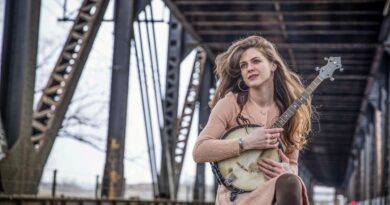Patterns in History: Bisa Butler Portraits at The Art Institute
On View at The Art Institute of Chicago this Winter, Bisa Butler: Portraits Tell a Rich Narrative of African-American Life
Creating a historical narrative can easily become an artform all its own. Weaving a cultural narrative with the potent messages worthy of conveyance from one generation to the next is no light pursuit. Transform that narrative from written language to a visual tapestry, and you bring real depth to history and culture merging into the realm of artistry. This winter, The Art Institute of Chicago will present a new exhibition that showcases the kind of artistry that makes history come alive. Bisa Butler: Portraits, on view at the museum through April 19, 2021 showcases 22 quilts in four galleries and engages viewers with poignant themes of family, community, migration and the promise of youth, artistic and intellectual legacies. Meticulously stitched with vivid fabrics that emerge in painterly portraits, Bisa Butler’s quilts convey rich, one-of-a-kind, multidimensional narratives of Black life.
Though Butler’s work participates in and carries on the African American quilting tradition, her process and technique have been evolved in very innovative ways.
Trained as a painter at Howard University, Butler shifted to quilting while pursuing her master’s degree at Montclair State University. She created her first quilt entitled Francis and Violette, based on a wedding photograph of her grandparents, as a project for a class on fiber art. While her early quilts depicted her own family and friends, in choosing subjects for her more recent works, Butler has pored over thousands of historical photographs. When she finds individuals that resonate with her aesthetic, she transforms the photograph and recreates it using hundreds, if not thousands, of fabric pieces that she layers and then stitches together. This elaborate and labor-intensive process can often take hundreds of hours to complete.
“The vibrancy and scale of Butler’s work really captivates viewers, and once they are pulled in, they experience an often startling realization regarding materiality; that is, they discover what they are looking at is fabric rather than paint. This surprise paired with the arresting faces of her subjects fuels even closer looking. The complementary layers of narrative and materials create an immersive, dazzling, and compelling aesthetic experience,” says Erica Warren, associate curator of Textiles at the Art Institute of Chicago.
Butler’s methods remain interdisciplinary, even though her finished works are exclusively fabric. She looks to photographs to inform her compositions and figural choices. She layers fabrics as a painter might layer glazes, and she uses thread to draw, adding fine detail and texture with her adroit stitching.
The fabrics chosen for her textile portraits also speak succinctly to a shared African diasporic history; many of the printed fabrics she employs often originate in West African countries, including Ghana (her father’s country of origin). The integration of subject, textiles and materials in Butler’s elaborate quilts may often mirror the layered and diasporic nature of African-American life in America.
“In my work I am telling the story— this African-American side— of the American life,” explains Bisa Butler. “History is the story of men and women, but the narrative is controlled by those who hold the pen.”
Among highlights of this exhibition is a life-size textile portrait entitled The Safety Patrol. The quilt is based on a Charles “Teenie” Harris photograph of a young boy with his arms stretched protecting six other children behind him. The piece was acquired by The Art Institute in 2018.
Another work shown in the exhibition is Butler’s Southside Sunday Morning, a quilt that brings to life the historic 1941 Farm Security Administration (FSA) photograph by Russell Lee. The image presents 5 African American boys, dressed in their Sunday finest, sitting atop a car on Chicago’s southside. The bravado so sharply conveyed in the black and white photo comes to brilliant life in Butler’s quilt through the intricate use of vibrant fabric colors to delineate and highlight each of the 5 subjects. The work represents a stunning iconic representation of African-American community.
Perhaps one of the biggest highlights of the exhibition is Butler’s Broom Jumpers. Set upon an orange-red background, the full-length image of a confident, newly married young African-American couple from the 1930s colorfully adorns the quilt. In a 2019 video interview following the Mount Holyoke College Art Museum’s acquisition of Broom Jumpers, Butler noted what initially drew her to this historic image was the expression of romantic love shown intimately in how the young couple held hands in the image. It was that singular romantic act that inspired her entire project. What does a young couple yearn for when newly married, she wondered? Butler envisioned that the young couple wished for love, unity and prosperity. These themes were then brought to life in the fabrics selected for each subject. Butler used a dark purple West African fabric typically associated with prosperity to detail the young man’s jacket while using an African print with an image of two birds taking flight from a bird cage; a fabric historically associated with female empowerment and the saying, “If you leave, I leave”, for the creation beautiful hat worn by the young lady. Each of the hundreds of richly colored fabric pieces Butler selected for the piece provide voice, texture and meaning to her representation of the kind of romantic love shown in the original black and white photograph.
Like the photographs upon which they’re based, Butler’s powerful quilts convey so much more than just an image or a scene. With powerful depth and dimension, these intricately layered patterns stitch together stories of a people and a culture and a time, each with its own very personal significance to Butler and to those with the opportunity to see her work.
Bisa Butler: Portraits is curated by Erica Warren, Associate Curator of Textiles. This exhibition is organized by the Art Institute of Chicago and the Katonah Museum of Art. A catalogue will accompany the show. To learn more about the exhibition, visit artinstitute.org.




